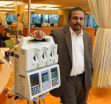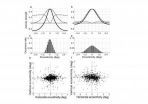(Press-News.org) BOSTON—In what they say is a promising and highly selective treatment strategy, scientists at Dana-Farber Cancer Institute have safely shut down breast cancer and a form of leukemia in mice by targeting abnormal proteins to which the cancers are "addicted," according to a new study.
Even though the investigators genetically silenced the proteins or blocked them with a drug in normal as well as cancerous tissues, the animals remained healthy, they report in the Oct. 16 issue of the journal Cancer Cell. Peter Sicinski, MD, PhD, of Dana-Farber is the paper's senior author.
The experiments targeted two related proteins, cyclin D1 and cyclin D3, that control cells' growth cycle. Many types of cancer have abnormal amounts of the proteins, spurring the cells to grow too rapidly and form tumors. The new results shown that the cancers' addiction to these proteins is an Achilles' heel that can be safely targeted with an inhibitor drug that halts cancer growth or causes cancer cells to die.
Based on the results, the Dana-Farber scientists are planning a clinical trial, using an experimental cyclin-inhibiting drug called PD0332991 that has already been tested in a form of lymphoma.
"It was impressive to find that you could target a single cyclin protein and completely clear the leukemia and the mouse remained healthy," said Yoon Jong Choi, PhD, the study's lead author. "We're excited because we think this approach is very promising" as a potential treatment for some cancer types, she added.
Some of the experimental mice had been engineered to develop a type of breast cancer driven by the ErbB2 oncogene. Others were modified to develop a type of T-cell acute lymphoblastic leukemia (T-ALL) that is driven by an abnormal pathway known as Notch1. In one experiment, human T-ALL cells were infused into mice that then developed the disease.
Blocking cyclin D1 in the mice drove the breast cancer cells into a kind of permanent retirement called senescence, an irreversible halt to their growth cycle. Inhibiting cyclin D3 in the T-ALL leukemia mice caused the cancer cells to self-destruct -- a programmed death process called apoptosis.
In addition to these tests with mouse cancers, the scientists found that the cyclin-D-inhibiting drug had similar effects on human blood cancer cells in the laboratory.
Cyclin proteins act as "checkpoint" guards to control cell's cycle of rest, growth and division. The D-cyclins determine when a cell begins making DNA in preparation for dividing to form new cells. In many types of cancer, an excess of cyclins allows cells to grow too fast and form tumors. Abnormal cyclins D1, D2 and D3 are found in breast, lung, endometrial, pancreatic, and testicular cancers and in multiple myeloma and other blood cancers.
In a key report in Nature in 2001, Sicinski showed that mice engineered to lack cyclin D1 were resistant to developing breast cancer. It wasn't known for many years, however, whether knocking out cyclin D1 could halt an established cancer, or if breast cancer needed the protein long-term.
Also unknown was whether normal cells could get along without cyclin D1: If not, treating cancer by targeting the protein might be too dangerous.
To test these questions, Choi and her Dana-Farber colleagues developed a strain of mice with cyclin D proteins that could be inactivated at any time by treating the mice with the drug tamoxifen.
"By generating these 'conditional' knockout mice, we could address these questions for the first time," said Choi. The effect was global, affecting all the body cells, not just those that were cancerous. When the cyclin D proteins were turned off using this technique, the addicted cancer cells shut down while normal cells were unaffected.
The authors say the results show that blocking cyclin D "represents a highly selective anticancer strategy that specifically targets cancer cells without significantly affecting normal tissues."
INFORMATION:
Other authors of the report include Xiaoyu Li, MD, PhD, a co-first author, and Harald von Boehmer, MD, PhD, of Dana-Farber, and Andrew L. Kung, MD, PhD, formerly at Dana-Farber and now at Columbia University.
The research was supported in part by grants from the National Institutes of Health (R01 CA083688 and P01 CA080111 and P01 CA109901).
Dana-Farber Cancer Institute is a principal teaching affiliate of the Harvard Medical School and is among the leading cancer research and care centers in the United States. It is a founding member of the Dana-Farber/Harvard Cancer Center (DF/HCC), designated a comprehensive cancer center by the National Cancer Institute. It provides adult cancer care with Brigham and Women's Hospital as Dana-Farber/Brigham and Women's Cancer Center and it provides pediatric care with Boston Children's Hospital as Dana-Farber/Children's Hospital Cancer Center. Dana-Farber is the top ranked cancer center in New England, according to U.S. News & World Report, and one of the largest recipients among independent hospitals of National Cancer Institute and National Institutes of Health grant funding. Follow Dana-Farber on Facebook: www.facebook.com/danafarbercancerinstitute and on Twitter: @danafarber .
Targeting cancers' 'addiction' to cell-cycle proteins shuts down tumors in mice
2012-10-17
ELSE PRESS RELEASES FROM THIS DATE:
Scientists to EPA: Include women in reproductive health research
2012-10-17
CHICAGO --- A team of Northwestern University scientists will meet with Environmental Protection Agency (EPA) administrators in Washington D.C. Oct. 18 to advocate for important changes in the agency's guidelines for reproductive health research.
"The problem is current research assessing the risk of toxins on reproductive health is not being uniformly investigated in both sexes and across the lifespan," said Kate Timmerman, program director of the Oncofertility Consortium of Northwestern University, who will be one of the scientists meeting with the EPA. The reproductive ...
Political empowerment fading for black Americans in the 'Age of Obama'
2012-10-17
Hailed by some as the "end of race as we know it" and the beginning of a "post-racial" America, the 2008 election of Barack Obama sparked a measurable bump in feelings of political empowerment among black Americans.
But those sentiments have faded considerably over the last year or so, according to a new analysis of political survey data, with the sharpest declines in perceived political power coming among blacks who identify themselves as conservatives or "born again" Christians.
"The election of a black American to the U.S. presidency did seem to empower African Americans, ...
Obese teen boys have up to 50 percent less testosterone than lean boys, UB study finds
2012-10-17
BUFFALO, N.Y. -- A study by the University at Buffalo shows for the first time that obese males ages 14 to 20 have up to 50 percent less total testosterone than do normal males of the same age, significantly increasing their potential to be impotent and infertile as adults.
The paper was published online as an accepted article in Clinical Endocrinology.
The authors are the same researchers in the University at Buffalo's School of Medicine and Biomedical Sciences who first reported in 2004 the presence of low testosterone levels, known as hypogonadism, in obese, type ...
Common birth control device may be cost-effective treatment for early endometrial cancer
2012-10-17
AUGUSTA, Ga. – A common birth control device is effective in treating early-stage endometrial cancer in morbidly obese and high-risk surgery patients, said Georgia Health Sciences University Cancer Center researchers, and could lead to a cost-effective treatment for all women with this cancer type.
Endometrial cancer, which starts in the lining of the uterus, is the third most common gynecologic cancer, striking more than 47,000 American women every year, particularly the obese. "Total hysterectomy, sometimes with removal of lymph nodes, is the most common treatment ...
Abnormal involuntary eye movements in amblyopia linked to changes in subcortical regions of brain
2012-10-17
Amsterdam, NL, October 16, 2012 – Little is known about oculomotor function in amblyopia, or "lazy eye," despite the special role of eye movements in vision. A group of scientists has discovered that abnormal visual processing and circuitry in the brain have an impact on fixational saccades (FSs), involuntary eye movements that occur during fixation and are important for the maintenance of vision. The results, which raise the question of whether the alterations in FS are the cause or the effect of amblyopia and have implications for amblyopia treatment, are available ...
Viral alliances overcoming plant defenses
2012-10-17
PULLMAN, Wash.— Washington State University researchers have found that viruses will join forces to overcome a plant's defenses and cause more severe infections.
"These findings have important implications in our ability to control these viruses", says Hanu Pappu, Sam Smith Distinguished Professor of Plant Virology and chair of WSU's Department of Plant Pathology. "Mixed infections are quite common in the field and now we know that viruses in these mixed infections are helping each other at the genetic level to overcome host defenses and possibly lead to the generation ...
New paper reveals fundamental chemistry of plasma/liquid interactions
2012-10-17
Though not often considered beyond the plasma television, small-scale microplasmas have great utility in a wide variety of applications. Recently, new developments have begun to capitalize on how these microplasmas interact with liquids in applications ranging from killing bacteria for sterilizing a surface to rapidly synthesizing nanoparticles.
An interdisciplinary collaboration between researchers at Case Western Reserve University and the University of Notre Dame has revealed a critical interaction that is occurring at this plasma-liquid interface in that the electrons ...
Immune response may link social rejection to later health outcomes
2012-10-17
No matter which way you look at it, rejection hurts. Experiencing rejection from a boss, a friend, or a partner is difficult enough for many adults to handle. But adolescents, who are dealing with the one-two punch of biological and social change, may be the most vulnerable to its negative effects.
In a new study published in Clinical Psychological Science, a journal of the Association for Psychological Science, researcher Michael Murphy and colleagues examine the human immune response as a potential link between social stressors like rejection and later mental and physical ...
Jelly-like atmospheric particles resist chemical aging
2012-10-17
Cambridge, Mass. - October 16, 2012 - Atmospheric chemists at the Harvard School of Engineering and Applied Sciences (SEAS) have found that when it comes to secondary organic material in the atmosphere, there are two distinct breeds: liquids and jellies.
Secondary organic materials (SOM) are airborne particles that have begun to react with gases in the atmosphere. In the last 20 years' research and climate modeling, these SOM particles have been assumed to drift as liquids. In a liquid phase, the organic materials would absorb other compounds like ammonia or ozone very ...
NASA: How do you solve a problem like (Tropical Storm) Maria?
2012-10-17
The song "How do you solve a problem like Maria?" from the famous film "The Sound of Music" comes to mind when looking at NASA satellite imagery of Tropical Storm Maria churning in the western North Pacific Ocean. The answer lies in increased wind shear and cool ocean temperatures – two factors that can weaken the storm, but won't be present over the next day or two.
NASA's Aqua satellite passed over Tropical Storm Maria on Oct. 16 at 0355 UTC, 12:55 p.m. local time Tokyo/Japan (Oct. 15 at 11:55 p.m. EDT) and the Moderate Resolution Imaging Spectroradiometer (MODIS) instrument ...





